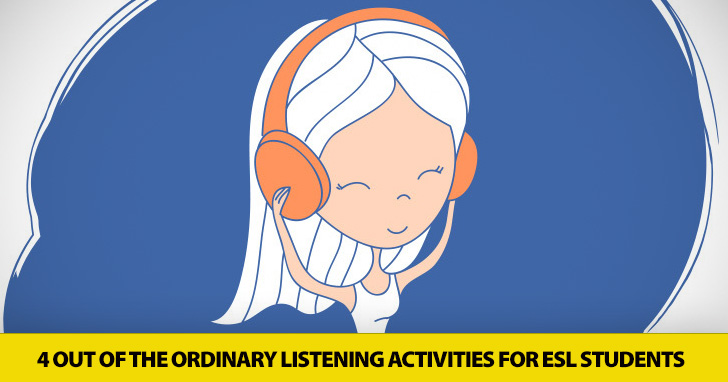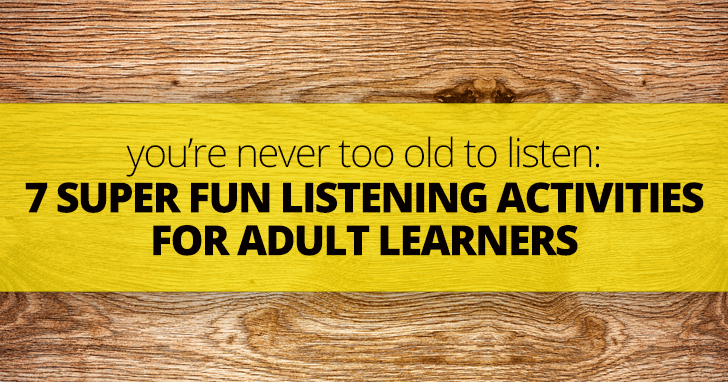Listen to This: 4 Out of the Ordinary Listening Activities for ESL Students


Adults are often self-motivated to learn. They know that they will make the biggest difference when it comes to their progress in English. They have a purpose for learning, and they are willing to apply themselves to achieve their goals. But adult learners can be challenging at times, too. They can become bored with lessons younger language learners enjoy. They sometimes feel as though the materials in your curriculum are too young for them, uninteresting. So how to you keep adult students engaged? By choosing activities that suit them where they are. Here are 7 listening activities that do just that.
Most adults are interested in current events, what is happening in the world. Appeal to this interest in your students by showing them all or part of a news program. News programs are good for ESL students for several reason. One is that newscasters generally have a very neutral accent. That’s why national news programs don’t sound like they were made for people in just one area of the United States with one particular accent. Another is that some news programs talk about events throughout the world, and internationals will likely be interested in hearing about events near their homes. You can find news programs on television every day, but you can also find several news segments online. Play a segment for your students and have them take notes as they listen. Then challenge them to take the information they heard in the news broadcast and put it into a newspaper article. The article should answer the key questions who, what, where, when, why, and how about the event and should be short and to the point.
Interviewing is a classic activity for language students, but here’s a twist on the standard. Rather than having students interview their classmates or native speakers (which are both great listening activities for your students) have them interview a character from a film. Show your students a movie or a portion of one, something that would appeal to the particular students in your class. After watching the movie, have students choose one character from the movie and write a fictional interview with that character. If you have done interviews before, students can use the list of interview questions you have used in the past. If not, take a few minutes to brainstorm the types of questions people generally ask in an interview before setting your students to task. Briefly introduce the characters they will encounter in the movie, and have students pick a few questions they would like to “ask” before watching the film. Students will have to listen closely to the character in the film to answer their interview questions accurately. Encourage students to take notes on the character as they watch the film.
Everybody likes music, and western music is often popular the world through. Bring a little of contemporary American culture into your classroom with one of today’s hit songs. You can do lots of activities with songs. Give your students a cloze exercise in which every fifth word of the lyrics is replaced with a blank. Play the song for your students and see how many of the blanks they can fill in correctly as they listen. When the song is over talk about what words actually complete the blanks. You can then review any unfamiliar vocabulary with your students, take some time to talk about rhythm and rhyme, and even give students an opportunity to write their own parody of the song.
You do role plays with your students all the time, and hopefully many of them simulate a situation in which students will actually use English when they have completed their language programs. Instead of having all of your students perform role plays at the same time, though, have two or three students do one roleplay in front of the class. As they act out their scenario, have the rest of your class listen closely. Once the role play is complete, ask your class some listening comprehension questions specific to the scenario that was played out before them. (The players themselves are not allowed to answer the questions.) Students will have to have understood the roleplay as well as retained the information (or taken notes on it) to answer your questions correctly. If you like, divide your class into two teams and award a point to whichever team can answer each of your questions first. Once each person has participated in a role play, the team with the most points wins.
See how well your students listen to each other with this pairs activity. Put your students in groups of two, and give each person a list of complex sentences that include grammar and vocabulary you are currently studying as well as some minimal pairs. You should have two different versions of the same sentences, each version with different words replaced by blanks. Each person in the pair gets one of the two sheets, and students must read their sentences to each other. Students will then have to listen closely to determine which words complete the blanks on their page and correctly complete their sentences.
Are you familiar with TED talks? These short speeches are available for viewing online for no charge, and they cover just about any subject you are interested in. Respected professionals in their fields present interesting information in less than five minute snippets, and with TED-Ed, you can make your own listening lessons based on the talks. Not only will your adult students find the talks interesting, they will also get the challenge of listening to real people using real life English.
Telephone conversations are a listening challenge for any English learner. Without body language clues, facial expressions, and visual pronunciation input, knowing exactly what the person on the other end of the line says is a real challenge. How much greater a challenge is it when your students cannot hear the other end of the conversation at all? Try playing a telephone conversation for your adult students, but only play one person’s side of the conversation. Then challenge your students to guess what the person on the other end of the line was saying. Play the conversation one time so your students get the gist of it. Then play it a second time and ask your students to write down what the absent person said. Play it one more time so they can check their work. Finally then reveal the second side of the conversation and see how close your students came to getting it right.
These listening activities will engage and entertain your adult learners and make sure their English skills are moving in the right direction without treating them like children.